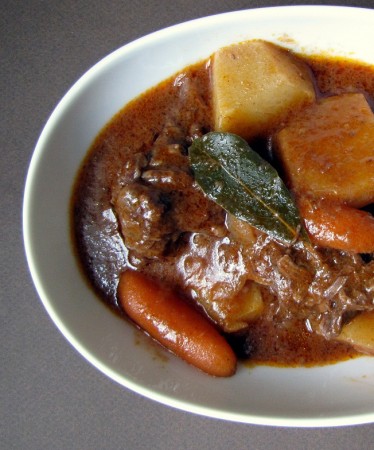 “Anyone who tells a lie has not a pure heart, and cannot make a good soup.”
“Anyone who tells a lie has not a pure heart, and cannot make a good soup.”
Leave it to the great Beethoven to mix morality with soup. (A tall order for his distressed servants, no doubt!)
Allow me to be “pure-hearted” here and share a recipe that represents a key nutritional foundation with a symphony of possibilities. This soup base is the foundation of every well prepared soup imaginable. Plus, it is free of MSG and preservatives that flavor many store-bought broths and soups.
I start with roasted bones and end with a gorgeous stock. I find that the most delicious and nourishing stocks are those made from a variety of bones, so plan to save your roast chicken, roast beef, pork, lamb, buffalo and rabbit.
Here’s what else you’ll need:
4 lbs (approximately) of bones (carcass, head, feet, cartilage, antlers, etc)
4 or more quarts cold, filtered water
½ cup vinegar, distilled or raw
2 apples, halved
3 onions, halved
3 celery stalks, halved
3 carrots, halved
Several sprigs of fresh thyme
1 tsp dried green peppercorns, crushed (optional)
1 bunch parsley (optional)
Once your roast has been served, add approximately 4 quarts of water to the roasting pan and scrape the bottom to infuse the drippings into the mix. Toss in any additional bones, heads, feet, etc. and add the remaining ingredients. Be sure that the bones are covered. If not, add more water.
I like to include apples and onions because they impart a sweeter aroma to a stock that might smell gamey otherwise. Vinegar is necessary to draw out the calcium, magnesium and zinc from the bones and render the bone stock more nutritious.
Then, set the pot to simmer for 12-72 hours. Skim off the scum and discard. The pot can remain on the flames for an entire 72 hours or turned off nightly, left at room temperature and reignited in the morning. Once strained, the stock can be frozen.
While it’s still on the stove, this stock can be used as a base for a myriad of soups. You might find that the stock doesn’t have a particularly appealing aroma but it will taste delicious after it’s strained and used to cook with.
With this base, you can offer “medicine in a bowl” in tandem with the other, family-pleasing meals you serve day after day.



Soup IS good food 🙂 Homemade soup is the best food of all!
Interesting association between truth and soup, but the truth is honesty is a virtue. I suppose it could also be called Virtue Soup. That has a ring to it.
I make stock from pastured animals when I can, but so far it’s only been with chicken & beef. I did have chicken feet to add at one time. One not accustomed to it just has to get over the sight. I make the broth, store it in glass jars in the freezer then sneak that into soups, rice, meatloaf & such when I can to upgrade whatever I’m cooking.
I think I’ll set my sights on collecting some of the other types of bones so my fairly good stock might come out gorgeous, too.
who would have thought that all those bones could hold so much nutrition for us..thanks for the tips!
I’ve always heard about how great a quality bone-stock can be for the health of my family… but I was never quite sure how to go about making one! Thank you for sharing with us…
so great! all the best chefs have a rich broth brewing or waiting – the base for their amazing dishes. this will be the new staple!
Much more a medicine than people realize. I used this type of soup stock to heal from an Inflammatory bowel disease. After coming home from the hospital and using this treatment they couldn’t even tell with new multiple biopsies and scopes I had previously had a problem. I add parsnips, onion, celery and carrots back in at the end, yummy!
Making stock is my favorite part of cooking with whole, pastured animals! Just finished off the last of an AMAZING chicken stock (put it into homemade chx noodle for a very feverish kiddo last week)… I used bones, giblets, roasted skin. It was so tasty! I’ve never thought to mix parts from different animals before, so I’ll have to try that next time! Thanks for the great tips, especially the vinegar one- I had no idea that would enhance the nutrient content 🙂
Thank you for this great stock recipe and process!
Your recipe process differs from many I’ve read in that it doesn’t require bringing the soup pot contents to an initial boil and then lowering the heat to simmer. Is there a reason that you don’t do an initial boil?
If I do the bone broth in a pressure cooker, do I have to wait for it to cool to know what to skim off? Do I skim off the hard fat layer? Can I drink it right away?